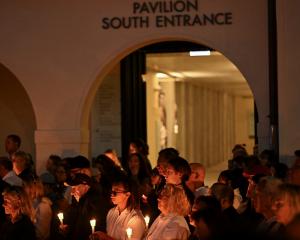A blizzard that has paralysed much of the East Coast of the United States has intensified, bringing Washington to a standstill and forcing the closure of roads, bridges and tunnels into New York.
In all, there were at least 19 deaths in several states related to the storm. It ranked No. 3 in terms of snowfall accumulation in New York City history with at least 63.7cm, and was among Washington's biggest also, the National Weather Service said.
Thirteen people were killed in weather-related car crashes in Arkansas, North Carolina, Kentucky, Ohio, Tennessee and Virginia. One person died in Maryland and three in New York City while shoveling snow. Two died of hypothermia in Virginia, officials said.
Aftert dumping 60cm of snow on the Washington area overnight, the storm unexpectedly gathered strength on Saturday as it spun northward and headed into the New York metropolitan area, home to about 20 million people.
With the storm persisting through the night, accumulations of between 60cm to 71cm of snow were expected in New York City, northern New Jersey and western Long Island, with winds gusting to 72kmh, the National Weather Service said. Visibility is expected to be one-quarter of a mile or less.
Mayor Bill de Blasio said that the accumulation could be two feet or more "when all is said and done, making it in the top five of storms to hit New York City."
Governor Andrew Cuomo declared a state of emergency as 10 other state governors have done. He also announced a ban on all travel on New York City area roads and on Long Island, except for emergency vehicles. All bridges and tunnels into the city from New Jersey were also closed and would be until the early hours of Sunday.
Heavy snow bands were moving across Long Island, New York City and northeast New Jersey, with wind gusts of up to 80kmh, the National Weather Service said.
In New York City, an otherwordly quiet descended on the usually bustling city of 8.5 million, the most populous in the US. Tourists and residents took to the streets of Manhattan, with many venturing into the white expanses of Central Park, some on skis. Others built snowmen or had good-natured snowball fights.
While authorities in New York and New Jersey halted public transportation, the Washington Metropolitan Area Transit Authority took the rare step of suspending operations through Sunday in the capital.
"The forecasts suggest that the snow will wrap up late tonight or in the very early hours of the morning," Washington Mayor Muriel Bowser said. "But it doesn't make it any less dangerous. We expect continued high winds throughout the area which will continue to make the conditions and visibility very poor."
About 5100 flights were canceled on Saturday and 2800 more on Sunday, said FlightAware.com, the aviation data and tracking website.
United Airlines said on Saturday that it would not operate at Washington-area airports Saturday and Sunday, and would gradually resume service on Monday. The airline plans to start "very limited operations" on Sunday afternoon at its Newark, New Jersey, hub and other New York area airports.
The brunt of the blizzard reached the New York City area after battering Washington, where snow had piled up outside the White House and the city's famous monuments were frosted with snow.
The record high of 71.1cm of snow in Washington was set in 1922 and the biggest recent snowfall was 45.2cm in 2010.
HIGHER TIDES THAN DURING SANDY
The snow also engulfed the Mid-Atlantic cities of Baltimore and Philadelphia while about 150,000 customers in North Carolina and 90,000 homes in New Jersey lost electricity in the storm on Saturday.
Tides higher than those caused by Superstorm Sandy three years ago pushed water onto roads along the Jersey Shore and Delaware coast and set records in Cape May, New Jersey, and Lewes, Delaware, said NWS meteorologist Patrick O'Hara.
Even so, there were only a few evacuations reported along the New Jersey Shore, where thousands of residents had to abandon their homes during the devastating 2012 storm.
The barrier islands near Atlantic City were experiencing significant tidal flooding, said Linda Gilmore, the county's public information officer.
The storm developed along the Gulf Coast, dropping snow over Arkansas, Tennessee and Kentucky on Friday. On the coast, warm, moist air from the Atlantic Ocean collided with cold air to form the massive winter system, meteorologists said.












